tow bar FORD ESCAPE 2002 1.G Owners Manual
[x] Cancel search | Manufacturer: FORD, Model Year: 2002, Model line: ESCAPE, Model: FORD ESCAPE 2002 1.GPages: 280, PDF Size: 2.75 MB
Page 93 of 280
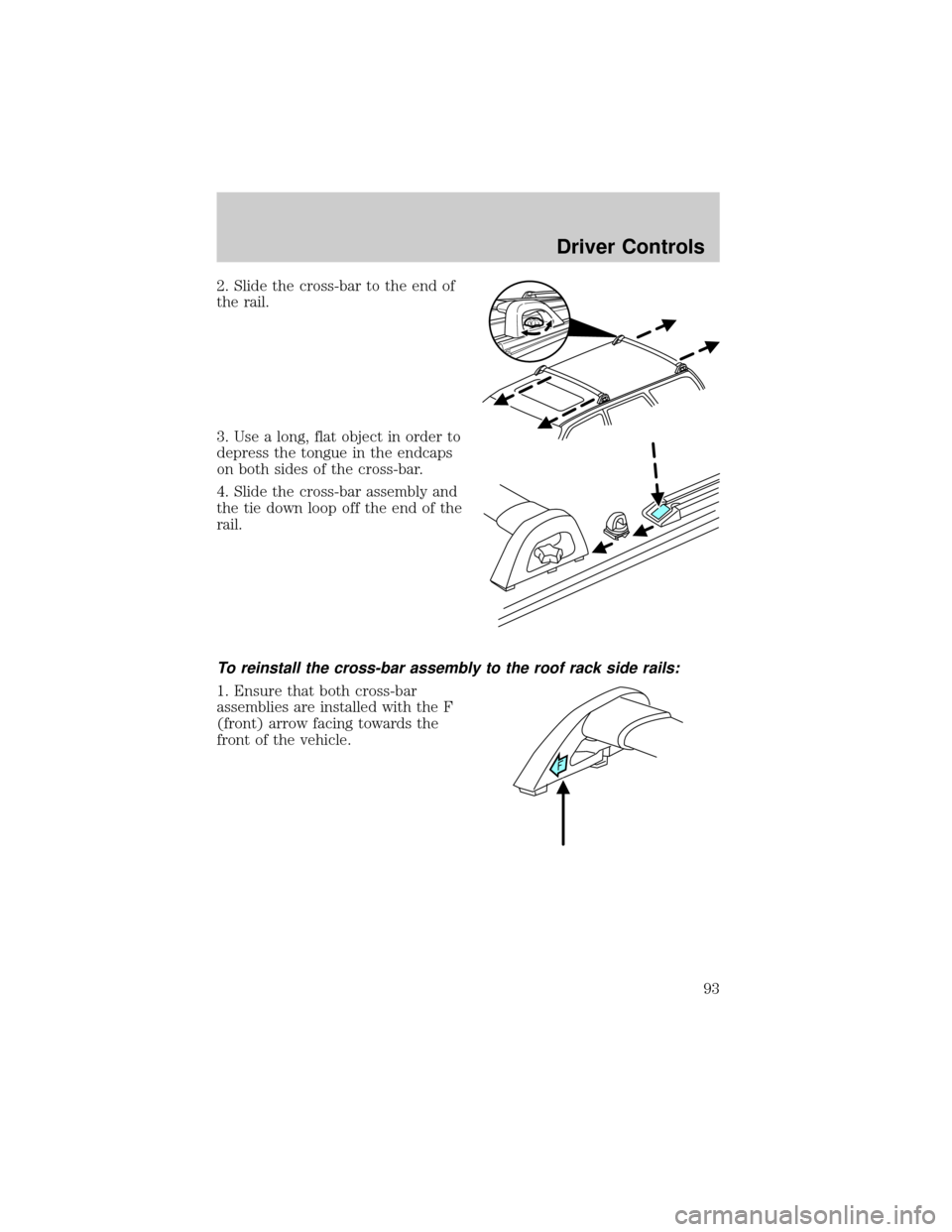
2. Slide the cross-bar to the end of
the rail.
3. Use a long, flat object in order to
depress the tongue in the endcaps
on both sides of the cross-bar.
4. Slide the cross-bar assembly and
the tie down loop off the end of the
rail.
To reinstall the cross-bar assembly to the roof rack side rails:
1. Ensure that both cross-bar
assemblies are installed with the F
(front) arrow facing towards the
front of the vehicle.
Driver Controls
93
Page 94 of 280
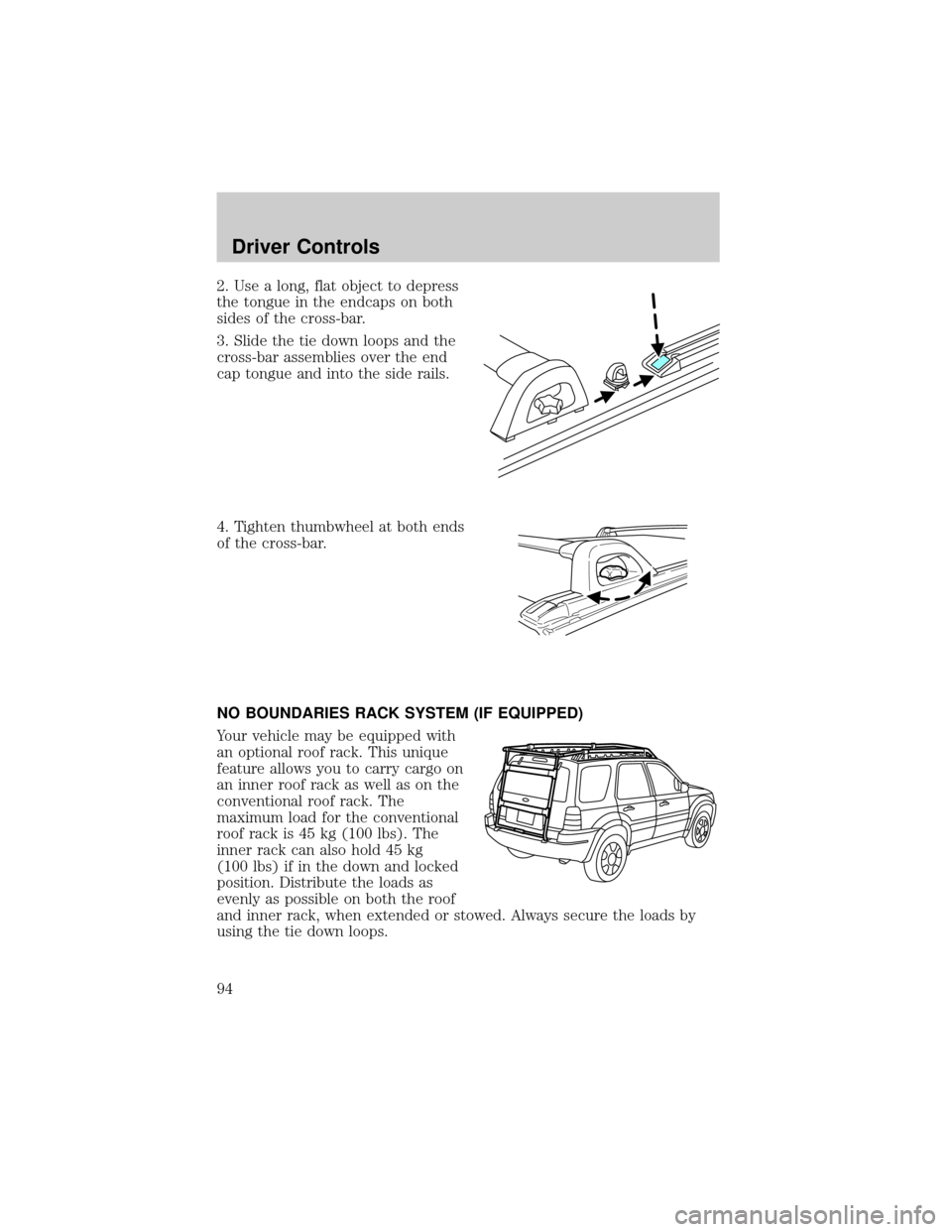
2. Use a long, flat object to depress
the tongue in the endcaps on both
sides of the cross-bar.
3. Slide the tie down loops and the
cross-bar assemblies over the end
cap tongue and into the side rails.
4. Tighten thumbwheel at both ends
of the cross-bar.
NO BOUNDARIES RACK SYSTEM (IF EQUIPPED)
Your vehicle may be equipped with
an optional roof rack. This unique
feature allows you to carry cargo on
an inner roof rack as well as on the
conventional roof rack. The
maximum load for the conventional
roof rack is 45 kg (100 lbs). The
inner rack can also hold 45 kg
(100 lbs) if in the down and locked
position. Distribute the loads as
evenly as possible on both the roof
and inner rack, when extended or stowed. Always secure the loads by
using the tie down loops.
Driver Controls
94
Page 95 of 280
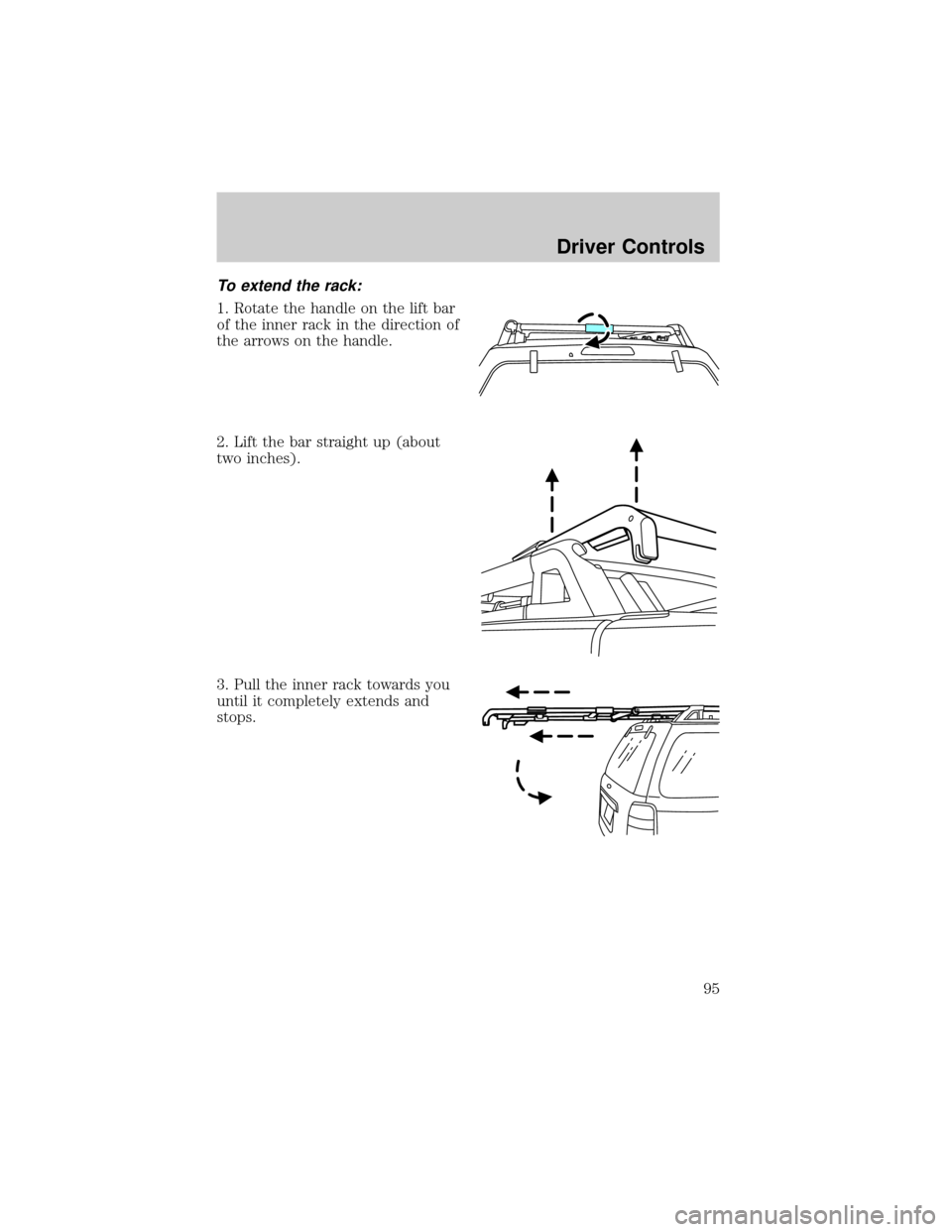
To extend the rack:
1. Rotate the handle on the lift bar
of the inner rack in the direction of
the arrows on the handle.
2. Lift the bar straight up (about
two inches).
3. Pull the inner rack towards you
until it completely extends and
stops.
Driver Controls
95
Page 98 of 280
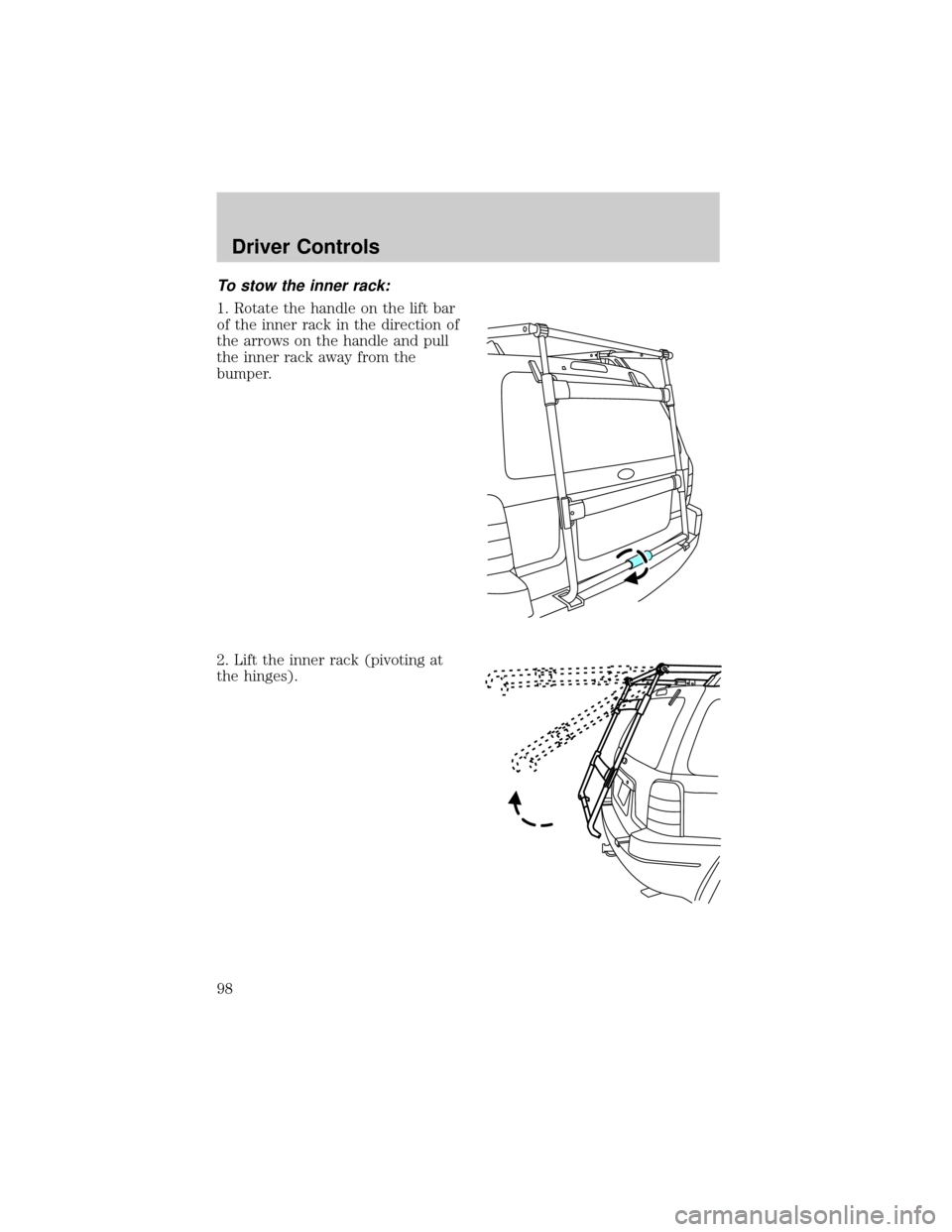
To stow the inner rack:
1. Rotate the handle on the lift bar
of the inner rack in the direction of
the arrows on the handle and pull
the inner rack away from the
bumper.
2. Lift the inner rack (pivoting at
the hinges).
Driver Controls
98
Page 100 of 280
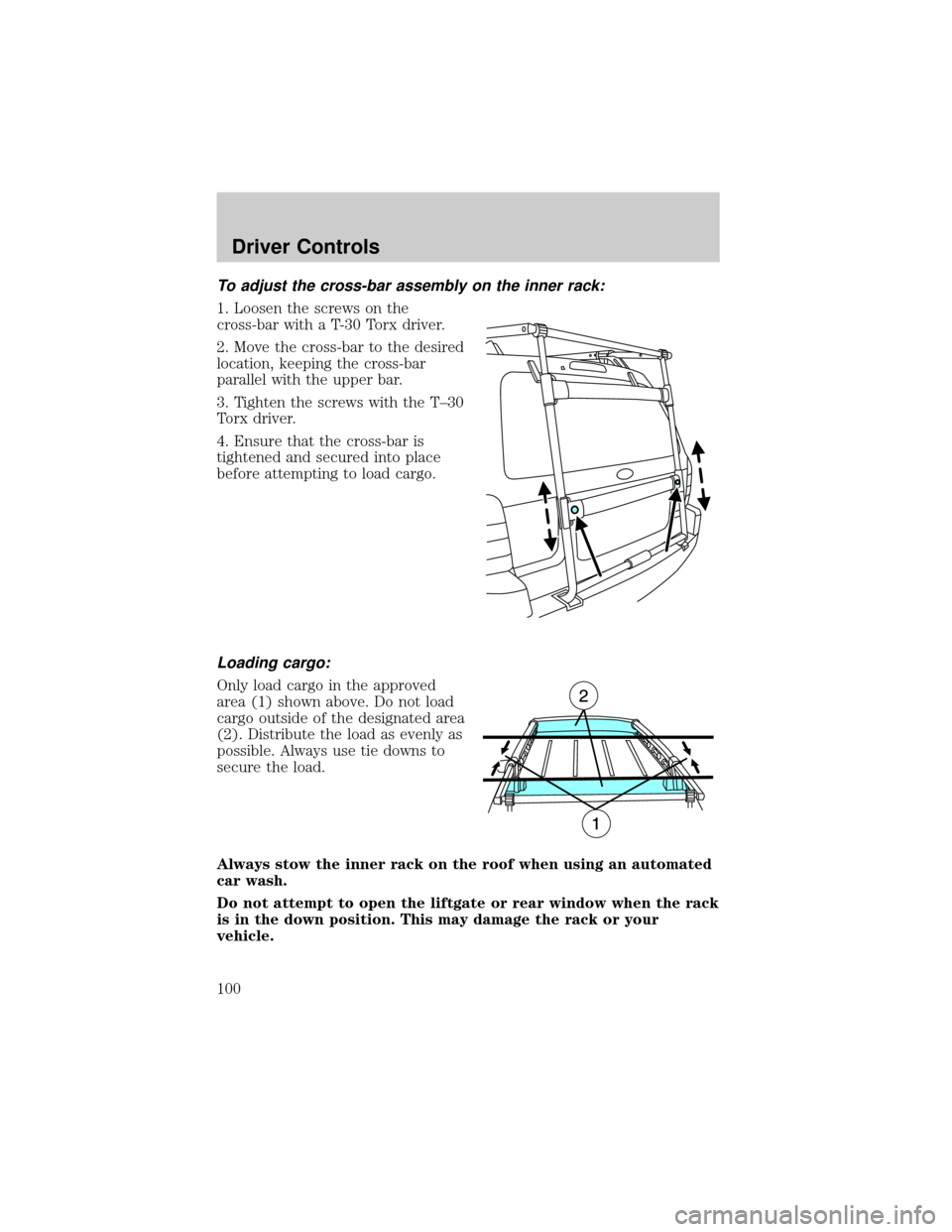
To adjust the cross-bar assembly on the inner rack:
1. Loosen the screws on the
cross-bar with a T-30 Torx driver.
2. Move the cross-bar to the desired
location, keeping the cross-bar
parallel with the upper bar.
3. Tighten the screws with the T±30
Torx driver.
4. Ensure that the cross-bar is
tightened and secured into place
before attempting to load cargo.
Loading cargo:
Only load cargo in the approved
area (1) shown above. Do not load
cargo outside of the designated area
(2). Distribute the load as evenly as
possible. Always use tie downs to
secure the load.
Always stow the inner rack on the roof when using an automated
car wash.
Do not attempt to open the liftgate or rear window when the rack
is in the down position. This may damage the rack or your
vehicle.
Driver Controls
100
Page 249 of 280
![FORD ESCAPE 2002 1.G Owners Manual ²Sudden or hard accelerations may reduce fuel economy.
²Slow down gradually.
²Driving at reasonable speeds (traveling at 88 km/h [55 mph] uses 15%
less fuel than traveling at 105 km/h [65 mph]).
² FORD ESCAPE 2002 1.G Owners Manual ²Sudden or hard accelerations may reduce fuel economy.
²Slow down gradually.
²Driving at reasonable speeds (traveling at 88 km/h [55 mph] uses 15%
less fuel than traveling at 105 km/h [65 mph]).
²](/img/11/4853/w960_4853-248.png)
²Sudden or hard accelerations may reduce fuel economy.
²Slow down gradually.
²Driving at reasonable speeds (traveling at 88 km/h [55 mph] uses 15%
less fuel than traveling at 105 km/h [65 mph]).
²Revving the engine before turning it off may reduce fuel economy.
²Using the air conditioner or defroster may reduce fuel economy.
²You may want to turn off the speed control in hilly terrain if
unnecessary shifting between third and fourth gear occurs.
Unnecessary shifting of this type could result in reduced fuel
economy.
²Warming up a vehicle on cold mornings is not required and may
reduce fuel economy.
²Resting your foot on the brake pedal while driving may reduce fuel
economy.
²Combine errands and minimize stop-and-go driving.
Maintenance
²Keep tires properly inflated and use only recommended size.
²Operating a vehicle with the wheels out of alignment will reduce fuel
economy.
²Use recommended engine oil. Refer toLubricant specificationsin
this chapter.
²Perform all regularly scheduled maintenance items. Follow the
recommended maintenance schedule and owner maintenance checks
found in your vehicle scheduled maintenance guide.
Conditions
²Heavily loading a vehicle or towing a trailer may reduce fuel economy
at any speed.
²Carrying unnecessary weight may reduce fuel economy (approximately
0.4 km/L [1 mpg] is lost for every 180 kg [400 lb] of weight carried).
²Adding certain accessories to your vehicle (for example bug
deflectors, rollbars/light bars, running boards, ski/luggage racks) may
reduce fuel economy.
²Using fuel blended with alcohol may lower fuel economy.
Maintenance and Specifications
249
Page 278 of 280

low fuel ......................................13
oil pressure ...............................12
overdrive off ..............................13
safety belt .................................12
service engine soon ..................10
turn signal indicator .................13
Load limits .................................178
GAWR ......................................178
GVWR ......................................178
trailer towing ..........................178
Loading instructions .................180
Locks
childproof ................................103
Lubricant specifications ...265, 267
Lumbar support, seats .............115
M
Manual transaxle
fluid, checking and adding ....256
Manual transmission
fluid capacities ........................262
lubricant specifications ..........267
Mirrors
fold away ...................................86
side view mirrors (power) .......85
Moon roof ....................................89
Motorcraft parts ................246, 262
O
Octane rating ............................245
Odometer .....................................17
Oil (see Engine oil) ..................231
Overdrive ...................................165P
Panic alarm feature, remote
entry system ..............................104
Parking brake ............................160
Parts (see Motorcraft parts) ....262
Power distribution box
(see Fuses) ...............................192
Power door locks ......................102
Power mirrors .............................85
Power steering ..........................161
fluid, checking and adding ....252
fluid, refill capacity ................262
fluid, specifications .........265, 267
Power Windows ...........................83
Preparing to drive your
vehicle ........................................162
R
Radio ......................................25, 46
Radio reception ...........................61
Rear window defroster ...............67
Relays ........................................189
Remote entry system .......103±104
illuminated entry ....................106
locking/unlocking
doors ................................102, 104
panic alarm .............................104
replacement/additional
transmitters .............................105
replacing the batteries ...........105
Roadside assistance ..................186
Roof rack .....................................92
Index
278